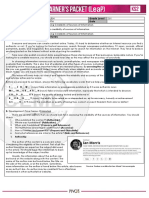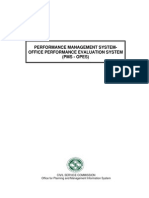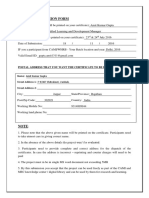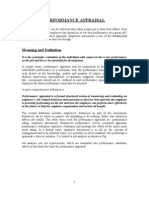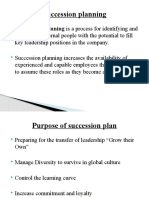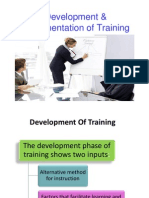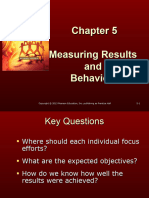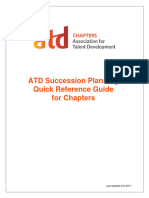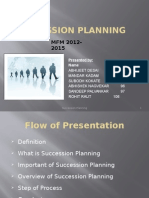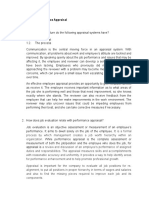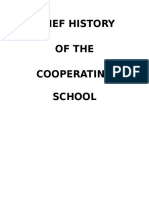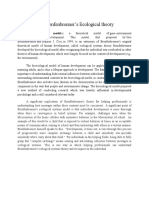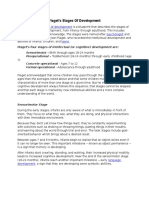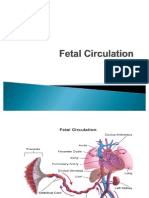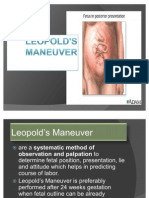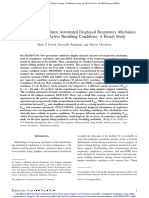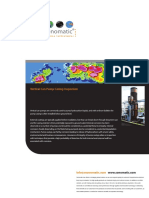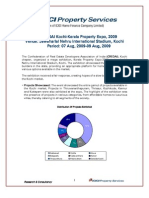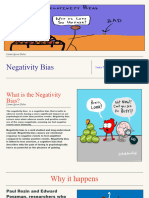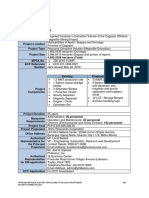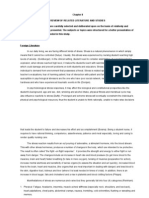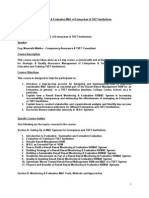0 ratings0% found this document useful (0 votes)
213 viewsPerformance Management Outline
Performance Management Outline
Uploaded by
Krestel Saligumba PalanogPerformance Management - Definition
Performance management is an ongoing process of communication between a supervisor and an employee that occurs throughout the year, in support of accomplishing the strategic objectives of the organization. The communication process includes clarifying expectations, setting objectives, identifying goals, providing feedback, and reviewing results.
Copyright:
© All Rights Reserved
Available Formats
Download as DOCX, PDF, TXT or read online from Scribd
Performance Management Outline
Performance Management Outline
Uploaded by
Krestel Saligumba Palanog0 ratings0% found this document useful (0 votes)
213 views4 pagesPerformance Management - Definition
Performance management is an ongoing process of communication between a supervisor and an employee that occurs throughout the year, in support of accomplishing the strategic objectives of the organization. The communication process includes clarifying expectations, setting objectives, identifying goals, providing feedback, and reviewing results.
Copyright
© © All Rights Reserved
Available Formats
DOCX, PDF, TXT or read online from Scribd
Share this document
Did you find this document useful?
Is this content inappropriate?
Performance Management - Definition
Performance management is an ongoing process of communication between a supervisor and an employee that occurs throughout the year, in support of accomplishing the strategic objectives of the organization. The communication process includes clarifying expectations, setting objectives, identifying goals, providing feedback, and reviewing results.
Copyright:
© All Rights Reserved
Available Formats
Download as DOCX, PDF, TXT or read online from Scribd
Download as docx, pdf, or txt
0 ratings0% found this document useful (0 votes)
213 views4 pagesPerformance Management Outline
Performance Management Outline
Uploaded by
Krestel Saligumba PalanogPerformance Management - Definition
Performance management is an ongoing process of communication between a supervisor and an employee that occurs throughout the year, in support of accomplishing the strategic objectives of the organization. The communication process includes clarifying expectations, setting objectives, identifying goals, providing feedback, and reviewing results.
Copyright:
© All Rights Reserved
Available Formats
Download as DOCX, PDF, TXT or read online from Scribd
Download as docx, pdf, or txt
You are on page 1of 4
At a glance
Powered by AI
The key takeaways are that performance management is a critical HR tool that helps organizations achieve their strategic goals and improve organizational effectiveness. It involves continuous processes of identifying, measuring, and developing individual and team performance through techniques like goal setting, monitoring, evaluation, and rewarding performance.
The different approaches to performance management discussed are the mixed model or total performance management approach, balanced scorecard, EFQM excellence model, performance prism, and investors in people (IIP).
The key elements of performance planning according to the document are planning and goals to clarify expectations, establish annual goals, and plan professional development.
Performance Management
By: Krestel S. Palanog, RN, MAN
Learning Objectives
1. To describe the performance management process and
show how organizations can manage both organizational
and employee performance
2. To explain the importance of performance
management in creating organizational effectiveness.
3. To demonstrate that performance management is a
strategic and integrated management process.
4. To describe the different techniques for measuring
performance.
5. To explain the importance of rewarding performance
6. To provide an example of performance management
in action through Miriam Colleges Performance
Management System.
Definition
1. Continuous Process of Identifying, Measuring, and
Developing. The performance of individuals and teams
2. Aligning performance with Strategic Goals of the
organization
Performance management
- Is a critical human resources management tool.
- Performance should be managed, measured and
rewarded.
- Improves organizational effectiveness.
- Is a system that impacts and affects everyone in the
organization. It helps the organization achieve
business results and maintain its desired culture. It
enables employees to understand how they are
contributing to the organizations strategic priorities
and goals, what is expected of them, and how they
are doing as it focus on the employees growth and
development.
I. Theoretical Bases
A. Performance Management: A strategic and
Integrated Management Process
Three perspectives are as follows:
1. Performance Management at the Organizational
Level
2. Employee Performance Managements
3. Integrated Performance Management System
1. Performance Management at the Organizational
Level
The focus is on the determination of the
organizations strategy, and the implementation of
the strategy through the organizations structure,
technology, business systems and procedures.
Employees are not the primary focus, although they
will be affected by changes in technology, structure
and operating systems (Williams, 1998)
Organizational perspective by Bredrup (1995) includes
the following activities
1. Performance Planning
- Formulation of vision and mission
- Meeting between employee and manager.
- Set SMART goals and measurement
standards
2. Performance Improvement
- Business process re-engineering
3. Performance Review
- Embraces measurement and evaluation
2. Employee Performance Management
-The focus is on engaging employees on planning their
goals, managing their performance, reviewing their
progress and developing themselves. It emphasizes the
contributions of employees who meet their targets and
demonstrate exemplary behavior are rewarded.
Schneier, Beatty & Baird (1986) identified the following
elements in this perspective:
o Planning involves establishing performance
targets, identifying job behaviors, and identifying
performance measures.
o Managing involves monitoring behavior and
objectives, reinforcing desired behaviors and
objectives attainment, and redirecting inappropriate
behavior
o Appraising involves formal meeting of employees
and manager, performance plan documents, focus on
future and employees development and re-planning,
and new objective establishment.
3. Integrated Performance Management
It is strategic and integrative.
It is strategic because performance management
pushes the realization of the strategic goals of the
organization.
It is integrative because it aligns and links the
organizations strategic direction with individual
performance.
Integrate the organizational and employee
performance to support the overall goals by linking
the work of each individual for the overall mission
of the unit.
It is about directing and supporting employees to
work as effectively and efficiently as possible in line
with the needs of the organization.
II. PERFORMANCE MANAGEMENT APPROACHES
A. Mixed Model or Total Performance
Management Approaches
B. The Balanced Scorecard
C. European Foundation for Quality Management
(EFQM) Excellence Model
D. Performance Prism
E. Investors in People (IIP)
Mixed Model or Total Performance Management
Approaches
A performance management system that combines
planning, management, and appraisal of both
performance results and competency behaviors is called
a mixed model of performance management or total
performance management approach.
Components of Performance Management
1. Performance Planning - Planning & Goals
Clarify expectations
Establish annual goals
Plan professional development
2. Performance Monitoring, Coaching and review
Ongoing Review, Coaching and Feedback
Confirm areas for focus
Provide constructive feedback
Documentation
3.Evaluation and Development Discussion
Summarize critical goals and achievements
Establish overall rating
The Balanced Scorecard
-An approached to performance measurement by
combining traditional financial measures with non
financial measures to provide managers with richer and
more relevant information about organizational
performance, particularly with regard to key strategic
goals.
-Four perspectives (financial, costumer, internal
processes and learning and growth)
-It aims to enable organizations to manage strategy
-It aims to achieve a balanced set of performance
measures and targets that allow managers to track
progress in key areas
European Foundation for Quality Management
(EFQM) Excellence Model
-Is a comprehensive organizational development and
improvement framework used for assessing strengths
and areas for improvement across the spectrum of the
organizations activity.
-The model comprises of nine criteria five enablers
and four results
-Five key enablers of excellence are leadership, policy
and strategy, people, partnerships and resources, and
processes.
-Four result: people results, and ultimately, key
performance results.
Performance Prism
-It is a stakeholder centric framework for performance
measurement and management.
-It does this in two ways: one, by considering the current
and future wants and needs of the stakeholders, and two
and more uniquely, by considering what the organization
wants and needs from its stakeholders.
Investors in People (IIP)
-Is the standard for improving organizational
performance by training and developing people to
achieve business goals.
Four key principles:
- Commitment to invest in people to achieve
business goals
- Planning how skills, individuals and teams
are to be develop to achieve this goals
- Action to develop and use necessary skills
- Evaluating outcomes of training and
development for individual progress towards
goals, the value achieved, and future needs.
III. MEASURING PERFORMANCE
Measurement is a focal point of performance
It is an assessment of progress against set performance
standards thru goals and objectives, which is expected to
be unbiased and quantifiable.
A. The need for performance measurement
A performance measurement system fulfills the following
purposes (Bredrup, 1995)
- Decision support
- Monitor effect of strategic plans
- Performance evaluation
- Diagnosis
- Management of a continuous improvement
process
- Motivation
- Comparison
- Record development
B. Performance measurement system
-Measures of performance are defined as the tools for
evaluating whether an organizations goals and
objectives are being achieved or not.
The following performance measurement systems are
quoted from the Performance Management Research
Report of the Organizational Systems International
(OSI, 2002)
1. Management by Objectives
2. Behaviorally Anchored Rating
3. Qualitatively Measurable Performance Criteria
4. 360 degree Feedback
Management by Objectives
-Is a systematic and organized approach that allows
management to focus on achievable goals and to attain
the best possible results from available resources.
Behavioral Anchored Rating Scales (BARS)
-Descriptions provided on appraisal forms and surveys
which describe a precise level of performance. It was
develop to improve raters accuracy by providing jobrelated behavioral anchors and alternating the format of
rating scales.
Qualitatively Measurable Performance Criteria
-It thought to be objective, reducing conflict between
the employee and the appraiser by restricting the focus
of the appraisal to items that can be measured by number
or quantity (e.g., increased production rate by the end of
the fiscal year, etc.)
360 degree Feedback
-Multiple rater and 360 degree feedback consist of
performance data generated and analyzed from a number
of sources: the employees immediate supervisor(s),
peers, and direct reports, suppliers, and internal and
external costumers.
IV. REWARDING PERFORMANCE
-Means recognizing employees, individually and as
members of teams, for their performance, and
acknowledging their competencies and contributions to
realizing the organization's strategies goals.
-Good performance should be recognized and should be
rewarded.
-Incentives and rewards like cash awards, bonuses, merit
pay and other non-monetary types of incentives to
motivate employee to perform at their best
V. The Miriam Colleges Performance Management
System
A careful, deliberate and thoughtful process was initiated
towards improving its appraisal system. This system
eventually became the core management process of the
institution.
Miriam College is an exclusive womens college in the
Philippines with the vision of Forming Women Leaders
in Service.
Statement of the Human Resource Philosophy
Miriam College (MC) is committed to provide the
members of its community with continuing opportunities
to achieve and excel in ones field, profession or job; to
grow professionally and personally to their fullest
potentials; and to make a meaningful contribution to the
institutions vision and mission.
Policy
This requires twelve-month cycle of planning,
monitoring and reviewing which commences in April
and ends in March of each school year
Objectives
- Align individual and organization
- Provide feedback on employees work progress and
accomplishment
- Provide information for planning, training and career
development programs.
- Provide structural basis for decisions on personal
movements.
- Encourage open communication and a supportive
relationship
Scope
The policy governs all non-teaching staff, referring to
administrators, professionals and administrative
personnel.
Employees must have completed at least six month of
work before being given a performance review.
Procedure
An objective and meaningful system of assessing
performance focus on:
- Contribution 60%
- Competencies 40%
Performance Planning
1. Expected Contributions and Achievements
2. Desired Competencies
Performance Monitoring and Coaching
Multiple Raters
Performance Planning
At the beginning of calendar year, all unit heads (to refer
to supervisor, manager, and administrator) will meet
individually with their staff and agree on employees
performance plan for one year period.
The plan includes specific targets that define the
employees' contribution.
Performance Monitoring and Coaching
- Throughout the performance cycle, it is the
responsibility of the rater (or the immediate supervisor)
to gather information about the work activities of the
employee, periodically checking on progress and quality
of output among others.
Performance Review
1. Performance Rating or Assessment
- This steps involves documenting and measuring
current performance against the targets or
standard that have been agreed on during the
performance planning.
2. Performance Discussion
- The second step involves a formal meeting
between rater and ratee giving them the
opportunity to discuss overall performance
results.
Performance management time cycle
The PMS is implemented according to the following
timetable:
VI. SUMMARY
Expected Contributions and Achievements
- Jobs defined goals
- Special Projects
- Improvement Targets
Desired Competencies
- The school sets standards of behaviors or core
competencies that, it believes, enable a person to
perform ones job or task successfully.
PM is a critical human resource management tool.
One effective approached to PM is Total Performance
Management
Four key areas:
- Performance Planning
- Performance Monitoring and coaching
- Performance Evaluation and development
discussion
- Rewarding performance
THANK YOU!
You might also like
- Gallup's Q12 Employee Engagement SurveyDocument3 pagesGallup's Q12 Employee Engagement Surveyorgdev.analyticsNo ratings yet
- Syllabus Ethnography of Space and PlaceDocument12 pagesSyllabus Ethnography of Space and PlaceVeronica TapiaNo ratings yet
- Guideline To Complete The 2012-13WSP and 2011-12ATR Template For The Employers in The ETD SectorDocument41 pagesGuideline To Complete The 2012-13WSP and 2011-12ATR Template For The Employers in The ETD Sectortangwanlu917740% (5)
- HANDOUTS On Performance Management Systems and Performance AppraisalDocument3 pagesHANDOUTS On Performance Management Systems and Performance AppraisalZooeyNo ratings yet
- Q4 English 6 Week6Document6 pagesQ4 English 6 Week6Maria Elaine De Castro100% (1)
- Basic Concept of Performance ManagementDocument1 pageBasic Concept of Performance ManagementandiNo ratings yet
- Performance Appraisal System Implementation 5Document35 pagesPerformance Appraisal System Implementation 5Pooja ThoratNo ratings yet
- Adeyemi's Final ProjectDocument156 pagesAdeyemi's Final ProjectADEYEMI AdedayoNo ratings yet
- Performance ManagementDocument18 pagesPerformance ManagementSaif HassanNo ratings yet
- PmsDocument4 pagesPmspavaniNo ratings yet
- PMS Guidelines 2007Document121 pagesPMS Guidelines 2007Gerry MicorNo ratings yet
- Training Employees: Read Unit 7 of Your TextDocument34 pagesTraining Employees: Read Unit 7 of Your TextGrace VersoniNo ratings yet
- R R R R R: #$ !$ % Bank Has Been A Forerunner in Initiating Customised and Focussed LeadershipDocument8 pagesR R R R R: #$ !$ % Bank Has Been A Forerunner in Initiating Customised and Focussed LeadershiprajeshrajenNo ratings yet
- Cldm-Competency Mapping - Amit Kumar GuptaDocument17 pagesCldm-Competency Mapping - Amit Kumar GuptaAmit GuptaNo ratings yet
- Performance AppraisalDocument24 pagesPerformance AppraisalSalil ThakurNo ratings yet
- Learning Training DevelopmentDocument17 pagesLearning Training Developmenttanjila tuli100% (1)
- Performance Management System and Appraisal: Presented To: Prof. Sanyunkta JollyDocument26 pagesPerformance Management System and Appraisal: Presented To: Prof. Sanyunkta JollyJnana Ranjan Pati100% (1)
- 7 Effective Delegation StepsDocument4 pages7 Effective Delegation StepsYeshitila Getachew100% (1)
- Career Management and DevelopmentDocument47 pagesCareer Management and DevelopmentJanelle TumamposNo ratings yet
- Training Needs Analysis PlaybookDocument8 pagesTraining Needs Analysis Playbookdiki more sariNo ratings yet
- Success Through HR ProfessionalsDocument44 pagesSuccess Through HR ProfessionalsRatneshwar KumarNo ratings yet
- Succession Planning: Succession Planning Is A Process For Identifying andDocument15 pagesSuccession Planning: Succession Planning Is A Process For Identifying andLokesh Soni100% (1)
- Training Need AnalysisDocument16 pagesTraining Need AnalysisHarsimran SinghNo ratings yet
- J2-Learning & Development Strategic Plan - FinalDocument18 pagesJ2-Learning & Development Strategic Plan - Finalسمير برناردو صابيرينNo ratings yet
- Training and DevelopmentDocument6 pagesTraining and DevelopmentMARC URRUTIA MIRÓNo ratings yet
- Sucession Planning Mandar Patil Tybms26Document6 pagesSucession Planning Mandar Patil Tybms26maddypatil4848No ratings yet
- Measuring ROI of TrainingDocument49 pagesMeasuring ROI of TrainingMuthyala Nagaraju100% (1)
- Concept of TrainingDocument52 pagesConcept of TrainingDhruv GuptaNo ratings yet
- HR Unit 1 Use.Document43 pagesHR Unit 1 Use.Chamare K WintNo ratings yet
- Development Implementation of TrainingDocument19 pagesDevelopment Implementation of TrainingAnurita Arya0% (1)
- Talent ManagementDocument17 pagesTalent ManagementVikram Verma100% (1)
- Aguinis pm3 PPT 05Document36 pagesAguinis pm3 PPT 05Felicia TangNo ratings yet
- Performance Evaluation Godrej & HUL PDFDocument4 pagesPerformance Evaluation Godrej & HUL PDFRomit PatelNo ratings yet
- Module 1 AssignmentDocument6 pagesModule 1 AssignmentAbhishek KumarNo ratings yet
- McLean & Company - Practical Tips For Creating A People StrategyDocument2 pagesMcLean & Company - Practical Tips For Creating A People StrategyCarolynNo ratings yet
- Assessment & Development Centers: Competency DefinitionDocument8 pagesAssessment & Development Centers: Competency DefinitionDaksh AnejaNo ratings yet
- Human Resource Management: Course Facilitator Dr. Sobia NasirDocument29 pagesHuman Resource Management: Course Facilitator Dr. Sobia NasirFatima Naaz100% (1)
- ROI in Training: Submitted by Sujitha Mol CSDocument6 pagesROI in Training: Submitted by Sujitha Mol CSsujithagnath100% (1)
- Application Form: Prospective Entrepreneurial Training Programme LearnerDocument3 pagesApplication Form: Prospective Entrepreneurial Training Programme LearnerTemia AlyssaNo ratings yet
- Md. Awal Al Kabir Assistant Professor Jahangirnagar UniversityDocument27 pagesMd. Awal Al Kabir Assistant Professor Jahangirnagar UniversityJahedul IslamNo ratings yet
- Integrated Talent ManagementDocument18 pagesIntegrated Talent ManagementmadinegoroNo ratings yet
- Module 3 AssignmentDocument4 pagesModule 3 AssignmentAbhishek KumarNo ratings yet
- Training & Development Practices at Mobilink Pakistan: Prepared byDocument19 pagesTraining & Development Practices at Mobilink Pakistan: Prepared byFahad FaridNo ratings yet
- Job Analysis - Definition, Importance, Components, Methods, Purpose, ProcessDocument37 pagesJob Analysis - Definition, Importance, Components, Methods, Purpose, ProcessShamsa ZahidNo ratings yet
- Career Planning and DevelopmentDocument20 pagesCareer Planning and DevelopmentShona KhuranaNo ratings yet
- Human Resource Planning and Job Analysis-NewDocument108 pagesHuman Resource Planning and Job Analysis-NewSupriya Vijay SulakhiNo ratings yet
- The Competency Modeling ApproachDocument4 pagesThe Competency Modeling ApproachsaospieNo ratings yet
- PMS Fast TrackDocument56 pagesPMS Fast Trackisharoy-1No ratings yet
- MU0013 - HR AuditDocument32 pagesMU0013 - HR AuditNeelam AswalNo ratings yet
- CLDM Project Guidelines at Version 5.2, February 2017Document22 pagesCLDM Project Guidelines at Version 5.2, February 2017GPNo ratings yet
- Performance ManagementDocument7 pagesPerformance ManagementmengelhuNo ratings yet
- ATD Succession Planning QRG For ChaptersDocument14 pagesATD Succession Planning QRG For ChaptersMuhammad Kadry100% (1)
- Ch08 HR Administration and HRISDocument44 pagesCh08 HR Administration and HRISHajar Almalki100% (1)
- Benchmarking: What It Is, What It Isn'tDocument6 pagesBenchmarking: What It Is, What It Isn'tSatya KumarNo ratings yet
- Succession PlanningDocument15 pagesSuccession Planningmandar100% (1)
- Which Leadership Type Is The Most Effective Transformational Transactional Taskfocused or People-FocusedDocument1 pageWhich Leadership Type Is The Most Effective Transformational Transactional Taskfocused or People-FocusedAlicjaONo ratings yet
- Model Evaluating Training ProgramsDocument3 pagesModel Evaluating Training ProgramsRoselita Yusof100% (1)
- Module 5Document6 pagesModule 5AllanCuartaNo ratings yet
- MangementDocument21 pagesMangementshubham rathodNo ratings yet
- Career Planning & Succession Planning: Prof. Preeti BhaskarDocument40 pagesCareer Planning & Succession Planning: Prof. Preeti BhaskarDrNeeraj N. RanaNo ratings yet
- Coaching: A Way to Individual Success and Organizational Effectiveness: 成功的關鍵:教練式領導(中英雙語版)From EverandCoaching: A Way to Individual Success and Organizational Effectiveness: 成功的關鍵:教練式領導(中英雙語版)No ratings yet
- Brief History of ACCDocument9 pagesBrief History of ACCKrestel Saligumba PalanogNo ratings yet
- Bronfen Brenner TheoryDocument2 pagesBronfen Brenner TheoryKrestel Saligumba Palanog100% (1)
- Piagets Cognitive Development by Kateleen Ureta and Stephanie AgueloDocument5 pagesPiagets Cognitive Development by Kateleen Ureta and Stephanie AgueloKrestel Saligumba PalanogNo ratings yet
- The Respiratory System (Intro)Document75 pagesThe Respiratory System (Intro)Krestel Saligumba PalanogNo ratings yet
- Perioperative Nursing 50 ItemsDocument4 pagesPerioperative Nursing 50 ItemsKrestel Saligumba Palanog100% (3)
- Contempt, Disgust, Distress, Interest, Surprise and Joy)Document1 pageContempt, Disgust, Distress, Interest, Surprise and Joy)Krestel Saligumba PalanogNo ratings yet
- GU ReviewDocument4 pagesGU ReviewKrestel Saligumba PalanogNo ratings yet
- KAP Study ProtocolDocument23 pagesKAP Study ProtocolKrestel Saligumba Palanog100% (1)
- Oxygenation Therapy and Steam InhalationDocument3 pagesOxygenation Therapy and Steam InhalationKrestel Saligumba PalanogNo ratings yet
- Fetal CirculationDocument8 pagesFetal CirculationKrestel Saligumba Palanog100% (1)
- Leopold's ManeuverDocument13 pagesLeopold's ManeuverKrestel Saligumba PalanogNo ratings yet
- Weight and Height MeasurementDocument27 pagesWeight and Height MeasurementKrestel Saligumba PalanogNo ratings yet
- Edpm Full NotesDocument32 pagesEdpm Full Notesaswathyachu74681No ratings yet
- The PROJECT PERFECT White Paper CollectionDocument2 pagesThe PROJECT PERFECT White Paper CollectionBlackmousewhiteNo ratings yet
- Life Sciences Study Materials Drawing Graphs 2012Document8 pagesLife Sciences Study Materials Drawing Graphs 2012api-202349222No ratings yet
- RICS Procurement of Facility Management 1st Edition 29 Oct 2020 PDFDocument56 pagesRICS Procurement of Facility Management 1st Edition 29 Oct 2020 PDFDilip RajNo ratings yet
- String Matching AlgorithmDocument14 pagesString Matching AlgorithmManohar NVNo ratings yet
- Design and Standardization of Base Frame & Ant Vibration Mounts For Balanced Opposed Piston Air CompressorDocument8 pagesDesign and Standardization of Base Frame & Ant Vibration Mounts For Balanced Opposed Piston Air CompressorilyaskureshiNo ratings yet
- Accuracy of The Ventilator Automated Displayed Respiratory Mechanics in Passive and Active Breathing Conditions: A Bench StudyDocument7 pagesAccuracy of The Ventilator Automated Displayed Respiratory Mechanics in Passive and Active Breathing Conditions: A Bench StudyLejlaNo ratings yet
- Vertical Can Pump Casing InspectionDocument2 pagesVertical Can Pump Casing InspectionsurawutwijarnNo ratings yet
- Afshan Hamid 468 P (45-64)Document20 pagesAfshan Hamid 468 P (45-64)International Journal of Management Research and Emerging SciencesNo ratings yet
- Stakeholder Theory - Reviewing A Theory That Moves UsDocument38 pagesStakeholder Theory - Reviewing A Theory That Moves UsMell YuliastinaNo ratings yet
- Prospectus: Indian Institute of Foreign TradeDocument6 pagesProspectus: Indian Institute of Foreign Tradesoni_2688No ratings yet
- Legal Issues in Forensic EngineeringDocument8 pagesLegal Issues in Forensic EngineeringwanlopNo ratings yet
- Draft DLLDocument2 pagesDraft DLLMaricar BumangladNo ratings yet
- Credai Kochi Expo 2009Document8 pagesCredai Kochi Expo 2009abhaimaniNo ratings yet
- Unit Test 2ADocument6 pagesUnit Test 2Aroberto salgado100% (1)
- Negativity BiasDocument7 pagesNegativity BiasNanka TinikashviliNo ratings yet
- Optimization of Blanching Process For Tender Jackfruit (Artocarpus Heterophyllus L.)Document8 pagesOptimization of Blanching Process For Tender Jackfruit (Artocarpus Heterophyllus L.)abhiNo ratings yet
- JDVC Public Hearing ESP EnglishDocument25 pagesJDVC Public Hearing ESP EnglishPrecious GenevineNo ratings yet
- The Tiny Big Threat A Narrative Case Study About Farmers Life Threatening Experience With Pests 1Document97 pagesThe Tiny Big Threat A Narrative Case Study About Farmers Life Threatening Experience With Pests 1lovryantadenaamilingacadsNo ratings yet
- MNO2603-101 2017 3 BDocument44 pagesMNO2603-101 2017 3 BMichael100% (1)
- Lecture S4Psychology of Criminal BehaviourDocument18 pagesLecture S4Psychology of Criminal Behavioursupervehl7468No ratings yet
- ZomatoDocument29 pagesZomatoSachin Joshi67% (3)
- Scientific SkillsDocument18 pagesScientific Skillsmmmmm12345mmNo ratings yet
- Discussion of The Format of The Concept PaperDocument4 pagesDiscussion of The Format of The Concept PaperE.J. PelayoNo ratings yet
- Review of Related LiteratureDocument10 pagesReview of Related LiteratureKamille Francisco74% (19)
- Monitoring Evaluation M E of Enterprises TVET Institutions Course ODocument3 pagesMonitoring Evaluation M E of Enterprises TVET Institutions Course OdiverhapNo ratings yet
- Freshie BookletDocument27 pagesFreshie BookletCJ DaodaoenNo ratings yet




